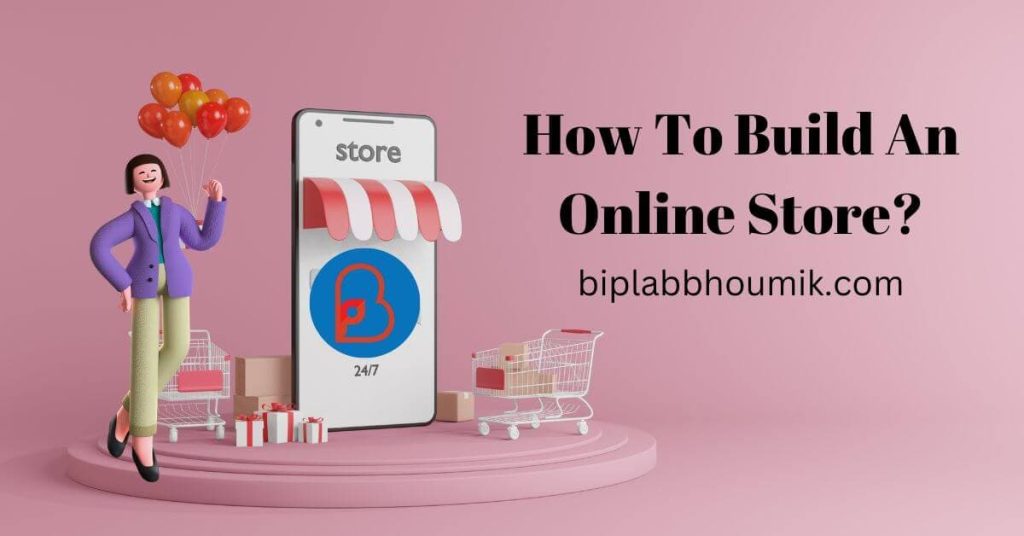Do you have a question, about how to start a blog? Starting a blog is a great way to share your thoughts and ideas with the world. There are many different ways to start a blog, and each has its own advantages. Whether you want to write about your favorite topics, reach new readers, or build an audience for your products and services, there’s a blog for you. In this post, we’ll explore some tips on how to get started.
First, think about what interests you and what you want your blog to represent. Next, find an online platform that will let you easily create a blog without any coding experience. Finally, create content that is interesting and engaging for your target audience. Please read the post carefully for starting a blog easily. Let us know if you have any questions or suggestions!
What Is A Blog?
A blog is a type of Website where people post articles, pictures, and other content on a regular basis. A blog typically has a front-page layout with links to recent posts at the top of the page, making it easy for readers to find what they’re looking for. Blogs can help you share your ideas and thoughts with the world, build an audience around your work, and make money from advertising.
How To Start A Blog?
There’s no one-size-fits-all answer to this question since the path to blog success is unique for each individual.
There are many ways to get started with a blog, and all of them have their own advantages and disadvantages.
A blog can be started in a number of different ways, with each possessing its own set of pros and cons but the most important thing is to have a passion for what you write about. If you have something interesting to say, then your readers will follow you.

1. Decide what you want your blog to be about. Are you interested in writing about fashion? Politics? Technology? There’s a world of topics out there for bloggers to choose from. Once you know what topic you’d like to write about, start researching and exploring different sources of information that could help support your argument or perspective.
2. Choose a platform and register with WordPress or another popular platform like Blogger or Tumblr. Once you have your platform set up, begin creating content by researching and writing articles related to the topic of your blog. Be sure to include multimedia elements such as photos and videos when possible!
3. Promote your blog by setting up Google Adsense ads or other forms of advertising that will generate income for your site over time. Or consider selling products through affiliate programs; this will allow you to share a small percentage of any sales made through links on your site.
4. Monitor your blog’s traffic and activity regularly to see which strategies are yielding the most results. If you find that your blog isn’t generating the desired level of income, consider making changes to the content, advertising, or affiliate programs to improve results. There is no “right” way to start a blog – just some basic tips that will help get you started in the right direction.
Here are the most important steps you need to take to start a blog and make money:
Choose A Niche and Blog Name
When choosing a niche and blog name, it is important to consider your choice or interest, after that the target audience, and what they are looking for. First and foremost, you need to determine the type of blog that you want to start. Are you looking for a personal blog that you can use to share your thoughts with the world? Do you want to start a business blog as an online extension of your company? There are many different types of blogs out there, so it is important to choose one that will fit your specific interests and goals.

Once you have determined the type of blog that you want to start, it is time to come up with a catchy name. It is best if your blog name relates directly to your niche or topic. For example, if you are writing about fitness, try naming your blog “Fitness Revolution” or “Minneapolis’ Best Running Group.” Once you have chosen a name and chosen a niche, it is time to get started buying domain and hosting.
Buy Domain and Hosting
Domain and hosting are important considerations when starting a blog, so it’s worth investing time in finding the best options. There are a few factors to consider when buying a domain name and selecting a hosting provider. First, you’ll want to make sure that the domain is available and that it meets your blogging needs. Second, you’ll need to find a provider with reliable infrastructure and customer service. Finally, make sure that the price and terms of your chosen hosting plan are affordable.
Domain Name
There are many domain-selling companies online. You can find a good domain name for your blog by searching for a domain name that is related to your niche and that is available. For example, if you are writing about fitness, you might want to look for a domain name like “fitnessrevolution.com” or “minneapolisbestrunninggroup.com.” You can buy a domain at a very reasonable price from Namecheap.
Web Hosting
There are many hosting providers in the world but all are not worthy for beginners. When selecting a hosting provider, it is important to find a provider with reliable infrastructure and customer service. It is also important to find a provider with affordable prices and terms of service. Some popular hosting providers include Bluehost, CloudWays, HostGator, WP Engine, Hostinger, etc. You can buy from any provider that you want to start your blog. My recommendation is Bluehost or CloudWays.
Choose a Blogging Platform (The best Option Is WordPress)
There are many CMS (Content Management Systems) available on the internet. WordPress is the most popular and widely used CMS. If you are planning to start a blog on your own, WordPress is the best option. It’s free to install, easy to use, and has a huge community of developers who can help you customize it to your needs.
WordPress isn’t the only option available, though – there are plenty of other platforms that can be just as effective for starting a blog. If you’re not familiar with any of these options, it might be worth taking the time to explore them before making a decision.

WordPress is the best option for many bloggers, but it is not the only option. There are a number of other popular platforms that can be used to create a blog, including Tumblr, Blogger, and Medium. It is important to select a platform that will meet your needs and desires as a blogger.
Once you have selected a platform, it’s time to get started setting up your blog. Connect domain and hosting each other and install WordPress. Once you have completed these steps, you are ready to start blogging!
Get Your Blog Online
Setting up a blog is one of the best ways to give your voice and opinion to the world. Whether you’re looking to share your thoughts on current events, promote your work or just have a place to store your ramblings, a blog is perfect for you. Here are some tips on how to get started:
1. Decide what you want to write about. You can start a blog about anything that interests you- whether it’s your life experiences, opinions on current events, or simply about things you love. Just make sure that whatever content you choose is interesting and relevant to others.
2. Choose a platform and register with it. There are many different platforms available, so it can be hard to decide which one is right for you. Some of the most popular options include WordPress, Blogger, and Medium. Once you have chosen a platform, register with it and begin creating content!
3. Get creative! A lot of bloggers start by simply writing out their thoughts in draft form and then editing them later if necessary. If this sounds like something that would be helpful for you, try using software like Grammarly or Hemingway to help you polish your writing.
4. Promote your blog and generate traffic. The best way to do this is by promoting your blog using social media channels like Twitter, Facebook, and Google+. You can also create unique content that can be shared on other websites or printed out and distributed to friends and family.
5. Evaluate your progress periodically and make changes as needed. As with anything else in life, blogging requires regular effort and dedication in order to be successful. Periodically evaluate your progress and make any necessary changes- this will help you stay motivated!
Install Theme and Customize your Blog
After installing WordPress, your blog is now online. But you should install themes and plugins for the best view and customize them for readers. You may find WordPress Themes at WordPress.org or you can install any premium themes from Themeforest, Elegant Themes, or Wix.com. The most popular theme for any beginner is Astra or GeneratePress. I personally used both themes. They are very lightweight themes and easy to customize.
Once you have installed WordPress, visit Appearance » Themes to find your theme.
On the right-side menu, click on “Install New Theme” and then enter the URL of your theme in the “Theme Location” field. After you’ve copied and pasted the link, click on “Upload Theme Files” to finish installing your theme.

If you want to use a premium WordPress theme, you will first need to purchase it. After you have purchased the theme, you will need to download the ZIP file and unzip it into your WordPress installation directory (usually located at wp-content/themes). Once you have unzipped the files, activate the plugin by going to Plugins » Add New » Activate Plugin and entering the details of the plugin into the “Name” field, and clicking on “Activate”.
You can also customize your blog’s look and feel with plugins like Elementor Page Builder. Once you have installed the required plugins and themes, head to the WordPress Settings area in your dashboard and click on “Plugins” to add new plugins or edit existing ones.
Top Essential WordPress Plugins you should Install on your Blog Today
Blogging is a great way to share your thoughts and experiences with the world, and there are many great tools and plugins available to help you get started. Here are some essential WordPress plugins that you should install on your blog today:
1. Google Analytics: This plugin allows you to track the traffic flow to your website, as well as gather information about who is visiting your site and what they are doing. This information can be helpful in understanding how people are using your blog and in planning future content.
2. Yoast SEO: This plugin helps you optimize your blog for search engines by correcting common issues like typos and incorrect titles, adding keyword density where necessary, and more. By making these changes, you can improve your ranking on search results pages and attract more visitors from across the web.
3. WPForms: This plugin lets you create custom forms to allow visitors to easily submit their data (like contact information or comments) without having to leave the page they’re on. This is a useful feature if you want to create a forum or ask readers for feedback on specific topics.
4. Jetpack: This plugin provides a range of essential features for bloggers, including social media integration, automatic backups, and more. It’s a good idea to have this plugin installed on all your blogs in order to maximize your blog’s potential.
5. Google Maps: This plugin lets you add interactive maps to your blog posts and pages, which can be helpful in providing visitors with directions or highlighting key locations on your site. By adding Google Maps to your blog, you can help visitors explore your content in an interactive way and help them find the information they’re looking for faster.
6. WPForms + Jetpack: This combination of plugins lets you create custom forms and automatically send the data collected through them to a third-party service like Salesforce or MailChimp. This is a great way to gather feedback from readers or backers about your products or projects and to keep track of customer data in an organized fashion.
7. Cloudflare: This plugin protects your website from attacks by blocking malicious traffic before it reaches your site’s servers. By installing Cloudflare on your blog, you can safeguard yourself against hacking attempts and reduce the risk of site downtime caused by malicious activity.
8. WPForms + Cloudflare: This combination of plugins adds even more security protections to Forms data by encrypting it before sending it off to a third-party service like MailChimp or Salesforce. By taking these steps, you can ensure that valuable customer data is safe from unauthorized access no matter what happens on the web.
9. Hootsuite: This social media management tool lets you keep track of all your social media accounts in one place, so you can see what’s happening with your brand on all the major platforms. Hootsuite also lets you schedule posts and respond to comments automatically, so you can focus on your business goals without having to worry about Twitter or Facebook control panels.
10. SumoMe: This plugin helps you grow your website’s traffic by providing targeted ads from top-performing Google Adsense and Facebook Ads partners. By using SumoMe, you can increase your web traffic by up to 500% while also cutting down on your advertising costs.
11. W3 Total Cache: This plugin speeds up your website by caching all the files that your site serves from its server. By caching these files, W3 Total Cache can reduce the time it takes your website to load by up to 80% overall.
12. KeepCalm & TakeAction: These two plugins help you take care of your business while you’re away from your computer. keepCalm sends you automatic email reminders to keep you on track, and TakeAction helps you take immediate action on any changes or updates that have been made to your website.
Research Audience & Keywords

Bloggers often wonder how to start a blog. The answer, of course, is to do your research! Begin by determining who your blog’s audience is and what keywords you should be targeting. Once you have an idea of who you are writing for and what topics to write about, begin drafting your first post. Take the time to craft a well-written article that will capture the attention of readers. Remember Quality over Quantity! Start with one or two posts per week and gradually increase as traffic and interest grow. Have fun with it!
What Makes a Good Blog Post?
A blog post should be well-written, informative, and engaging. It should aim to provide context for the reader and highlight key points. Additionally, posts should be timely and relevant, addressing issues that are currently affecting businesses or individuals. In order to create a successful blog post, it is important to follow certain guidelines.
To start, focus on quality over quantity. Write only when you have something important to say that will benefit readers. Be sure to proofread your work multiple times before publishing in order to ensure that all grammar and spelling mistakes are corrected. Additionally, make sure your post is formatted correctly – most blogs acceptably use a style guide provided by the website itself or a reputable online resource such as The Huffington Post.

Finally, make sure your content is shareable – whether through social media platforms such as Facebook or Twitter or through email distribution lists, shareable content is key for driving traffic back to your site. By following these tips, you can create high-quality blog posts that will help promote your business or website!
Write SEO-Friendly Blog Posts & Publish
Starting and publishing a blog can be a great way to share your thoughts and ideas with the world, but it takes some effort to get started. Here are some tips to help you write SEO-friendly blog posts that will be seen by more people:
If you want your blog posts to be seen by as many people as possible, make sure they are well-written and easy to read. Use clear language, keep paragraphs short, and use keywords throughout your article. Also, make sure your photos match the content of your article—if you’re writing about fashion trends, for example, include fashion photos in your article. Finally, consider using social media platforms like Facebook or Twitter to share links to your articles with friends and followers. Here are some of the best tips to follow:

1. Plan Your Posts Carefully
Before you start writing, make sure that each post is well-planned. Every sentence should have a purpose, and every paragraph should support the main point of the article. This will help your blog rank higher in search engine results pages (SERPs), making it more likely that readers will find your content.
2. Choose an Interesting Topic
Choosing an interesting topic is one of the most important steps in writing successful blog posts. If readers don’t care about what you have to say, they’ll stop reading after the first sentence or paragraph. Instead, focus on topics that are relevant to their own lives or interests. This will keep readers coming back for more, even if they don’t always agree with you!
If you want your blog to be successful, it’s important to share useful information. Not only will this encourage readers to visit your site more often, but it will also improve your ranking on search engine results pages.
4. Use Photos and Videos
Photos and videos are a great way to add personality and interest to your blog posts. Not only do they make your articles more visual, but they can also help you attract new followers and customers.
5. Ask for Feedback
Once you’ve published a blog post, be sure to ask for feedback from your readers. This will help you improve the quality of your content and ensure that it meets the expectations of all potential readers.
6. Promote Your Posts
Promoting your posts is an important part of building an audience for your blog. By sharing links to relevant blogs and social media platforms, you can help increase traffic to your site and promote brand awareness.
Add More Optimized Images in Every Post
Adding optimized images to your blog posts can help improve engagement and visibility. According to a study by Curalate, Optimized images are 73% more likely to be shared on social media than traditional images. Additionally, adding optimized images also increases click-through rates by up to 150%. Implementing these tips can help you add more optimized images to your blog posts:
1. Use High-Resolution Images: When choosing an image for your blog post, aim for high resolution if possible. This will increase the quality of the image and make it look more professional. Additionally, using high-resolution images will help increase the visibility of your blog post on social media platforms.
2. Choose Appropriate Images: Before uploading an image to your blog, make sure that it is appropriate for the content of the post. For example, if you are writing about fashion trends, don’t upload a picture of yourself with a mud mask on! Instead, choose an appropriate image from a reputable source (like Getty Images) or use one of our stock photos.
3. Use Flickr or Google Image Search: If you don’t have access to high-resolution images or suitable pictures, you can use Flickr or Google Image Search to find images that match your post’s topic.
4. Use More than One Image per Post: When uploading an image to your blog, try to use more than one image per post. This will help increase the visibility of your blog posts on social media platforms and make it easier for readers to find the images they are looking for.
5. Optimize Images: Once you have uploaded an image to your blog, you can optimize it using a few simple tools like Canva or Photoshop. These tools will help improve the appearance of the image, which will increase its visibility and click-through rate on social media platforms.
How to Optimize Images?
One of the first things you should do is optimize your image. By optimizing your images, you can reduce the load time of your blog, as well as improve the overall design and appearance of your site. There are a few things you can do to optimize your images for faster loading:
Choose high-quality images: When choosing images for your blog, make sure to choose high-quality images that will look good and load quickly. Try to use photos that are in focus and have low file sizes.
Optimize image size: When uploading an image to your blog, be sure to resize it so that it is smaller in size. This will help reduce the load time of your blog and make it look better on mobile devices.
Use creative file names: When naming your images, try to use creative file names that will help them load quickly. For example, instead of calling an image “image_1”, try naming it “sky_01” or “sunset_01”. This will give users more information about what they are looking at and will speed up their loading time.
Optimized Blog for Search Engine

1. Choose a topic that interests you. This is key; if you don’t have an idea of what you want to write about, it will be tough to create content that is search-engine friendly. If you can find a topic that is intriguing to you, it will be easier to keep your readers engaged.
2. Plan your posts ahead of time. Before you start typing away, make sure each post has an outline or rough draft so that everything flows logically and makes sense on the page. This will also help ensure that your blog looks professional and well-written.
3. Use keywords throughout your posts. When writing for the web, it’s important to include keywords in your titles, in the body of your text, and even in the URL (web address) of your website so people can find and click on your content when they are looking for information related to those terms.
4. Share valuable content with readers regularly. Blogging is all about providing value to your readers, so make sure you share helpful tips, interesting stories, and valuable content on a regular basis. This will keep them coming back for more and may even convince them to subscribe to your blog or even start making money from it!
5. Engage with your readers. If you want people to take notice of your blog and potentially subscribe, you need to be active in the comments section, respond to people who leave feedback, and interact with your followers on social media.
6. Promote your blog through social media. Although not everyone is interested in visiting your website or reading your posts on their desktop computer, many people are likely to follow you on social media networks like Twitter or Facebook if they are interested in what you have to say. By promoting your blog through these channels, you’re giving yourself a chance to reach a wider audience and potentially increase traffic to your website.
7. Keep an eye on Google trends. By monitoring how often specific keywords are being used on the web (and by extension, how popular your blog is), you can gauge which topics are resonating with readers and make changes (or add new topics) accordingly.
8. Use WordPress as your blogging platform of choice. WordPress is one of the most popular blogging platforms available today and is free to use for both personal and commercial blogs. With its user-friendly interface and multitude of features, WordPress makes it easy for beginners to get up and running with their own blog without any previous experience required!
Promote Your Blog for Better Results
Blogging can be a great way to promote your business and improve your visibility. There are a few things you can do to help increase the success of your blog:

1. Make use of social media platforms to promote your blog. You can use Twitter, LinkedIn, and Facebook to share links to your blog posts, as well as engage with potential followers.
2. Plan and write engaging content that will attract readers. Share interesting stories, insights, and tips on topics that are relevant to your audience. Make sure each post is well-written and easy to read.
3. Promote your blog through other channels such as paid advertising or sponsorships. This can help you reach new clients or followers who might not have discovered you otherwise.
4. Keep a consistent schedule for publishing new content on your blog. This will help readers develop an understanding of what to expect from you each time they visit the site.
Make Money from Your Blog
There are a number of ways to make money from your blog. You can sell advertising space, sell products, or offer subscriptions. It all depends on what you think will work best for your blog and audience. There are many online tools that can help you manage your blog and generate revenue.

1. Sell Advertising Space on your Blog
When your blog is popular day by day and some visitors can visit your blog, you can make money from your blog. You can sell advertising space on your blog to businesses or individuals. This can help you reach new followers and clients.
2. Sell E-books and other Digital Products
There are a lot of ways to make money from a blog, but the most common way is by selling e-books and other digital products. There are many platforms out there that allow you to sell your products, but the best way to find one is to do some research. There are also many self-publishing platforms that allow you to self-publish your books without any help. Once you have decided on a platform and product, it’s time to get started!
3. Selling Consulting Services
Consulting services are a great way to start a blog. There are many people who need help and consulting can provide that help. Consulting can be done in many different industries, so there is no limit to what you could write about. You could offer your services to businesses or individuals, or you could focus on a specific topic. Whatever you choose, make sure that you are competitively priced and provide excellent service.
4. Sell Products from your Blog through Affiliate Links
Blogging can be a great way to get your message out there and connect with potential customers. However, it can be difficult to monetize your blog without selling products through affiliate links. There are a few ways to do this:
1. Sell products through direct links on your blog. This is the easiest way to monetize your blog, but it can be risky because you’re relying on customers who have already shown an interest in your product to buy it from you.
2. Sell products through affiliate links. This is a more reliable way to make money from your blog, but it requires some effort on your part to set up affiliate links and track the results.
3. Offer free products in exchange for feedback or reviews. This strategy is especially effective if you have a unique product or service that other people might want to learn about.
5. Sell Products through your Own Online Store
There are a number of ways to monetize your blog through affiliate marketing and selling products through your own online store. This can be a great way to supplement your income and build a loyal following of readers who trust you to provide quality content. To get started, consider setting up an online store on Shopify or eBay, and then linking it to your blog. You can also create custom sales pages for each of your products, or use an existing sales page from an online retailer like Amazon or Walmart. Once you have a setup, start promoting your products by sharing news stories about them on social media, writing blog posts about them, and hosting giveaways.
Conclusion
Blogging is a great way to share your thoughts and experiences with the world. There are many ways to start a blog, and it doesn’t have to be complicated. Blogging can be a daunting task, but it is not as difficult as you might think. Whether you are just starting out or have been blogging for years, this guide will help you get started and ensure that your blog is successful. Follow these simple steps and you will be well on your way to creating a successful blog. I hope you like this post. If you have any queries, just comment below. Happy blogging!





